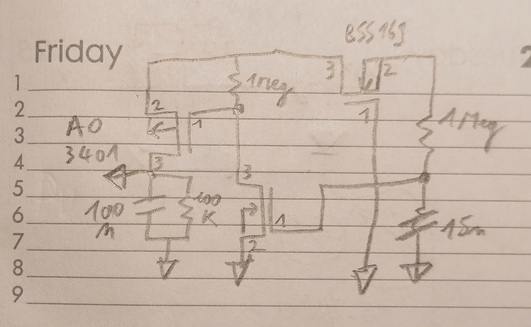Duty cycle
- 10ms ON = minimum needed for people to perceive full LED brightness
- 2s period = human beings are attracted by flashing periods from 0.5 to 5s. 2s is about in the middle of that range.
TPL5110 Low power timer
The TPL5110 is a very low power timer chip. Unfortunately, the minimum period is 100ms. This rules it out as an oscillator to generate LED pulses. To have a flicker free LED, the period should be equal to or lower than 20ms.
The TPL5110 could be used however to control the flashing period, in case flashing is desired.
14-03-2020
Circuitry
Yesterday's circuit worked fine, but it was overly complicated. This one does better. The BSS169 is a depletion NMOS. It's used here as a low power series regulator so that the 15nF is always charged at the same rate, no matter what input voltage is applied to the TPL5110. The source voltage of the BSS169 is about 2.2V for the charge current used in this application.
When powering at 3V3, the FDV301 triggers after 25ms, at 5V it triggers after 24.2ms.
To evaluate the TPL5110, the PRT-15353 from Sparkfun has been used. When the output of the TPL5110 is off, the current consumption is less than 100nA. It should be 35nA according to the datasheet.

After 25ms, the FDV301 releases the DONE-pin. Once DONE is high, the OUT will be powered down.

13-03-2020
Circuitry
To flash the LED, a TPL5110 is used. It will power up the LED every 2s. The circuit below turns the TPL5110 off again after 5ms. It should be >10ms. The 15nF capacitor needs to be increased. The drain of the AO3401 is connected to the DONE-pin of the AO3401.

Once the output turns on, the 15nF starts charging. After about 5ms the done-pin goes high. The output of the TPL5110 quickly goes down again. After that, the voltage slowly decays.

 Christoph Tack
Christoph Tack
Discussions
Become a Hackaday.io Member
Create an account to leave a comment. Already have an account? Log In.